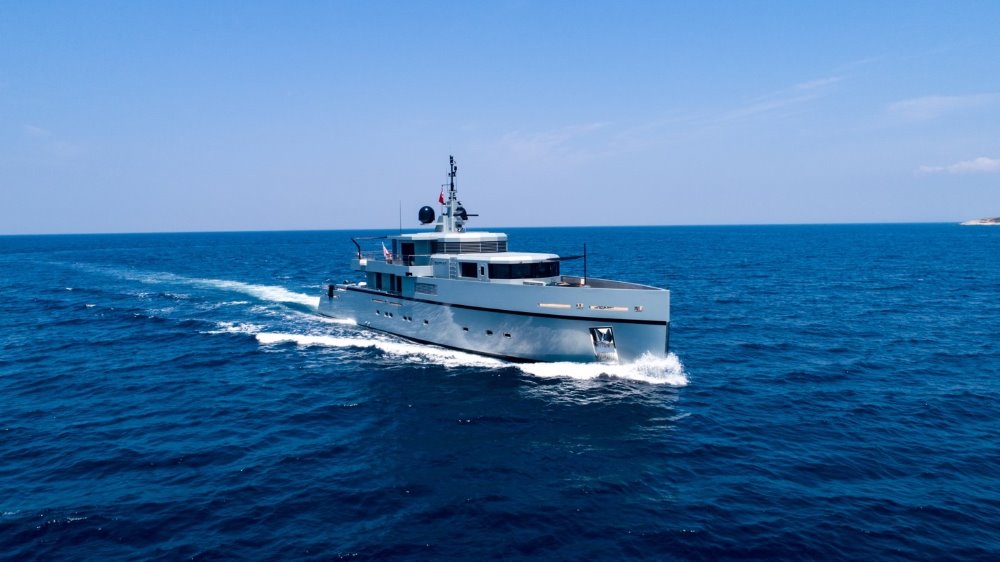Buying a superyacht is no small undertaking. From the shipyard and design, to the interior décor and the furnishings there is a huge list of choices and considerations to be made. Having usually chartered a few yachts, or owned smaller yachts before, prospective owners will have some idea of what it is they’re seeking, but long before it’s time to start talking colour palettes and cruising destinations, there are the more pressing decisions to be made, one of which is how to finance the yacht.
Of course, the simple option of paying cash for a superyacht is the most straightforward, but for those who would prefer to finance the purchase of a new build or used yacht there are many options available. With guidance from respected superyacht solicitor Mark Needham of Hannaford Turner, we take a look at the nuts and bolts of financing your next superyacht.

Yacht for sale: Award-winning M/Y SO’MAR is a 37.9m, Tansu Yachts.
Why Finance a Superyacht?
There is a myriad of reasons why someone would opt to finance their yacht instead of paying cash. Personal financial situations and business ventures will all play a very individual role in the decision, but ultimately the decision comes down to how much money someone wants to have committed in their asset. Perhaps the option to pay half now and half over the next few years as cash flow increases or shares mature allows for the purchase of a larger yacht. Or by using finance there is cash freed to invest in other business ventures. Whatever the reason, finance is an interesting opportunity for anyone in the market for a superyacht, whether it’s a new-build project or a used yacht purchase.
“There is no difference between the number of owners financing for charter or privately owned” Mark explains when asked whether the use of the yacht affects how it is purchased. “The two things are not necessarily connected. Likewise, finance can be for both new-builds and second-hand yachts, and there is no clear pattern of one more than the other. If anything, from my own personal experience, I would say it is more common on the purchase of a used yacht”.
Asset-Backed Finance versus Assets under Management
According to Mark, a pure asset-back finance, where the loan is fixed on the asset, is the most preferable option for those looking to finance a yacht. “From a borrower’s point of view, this is the most preferable as the finance is tied up with the asset without having different assets securing the finance” he explains. What he’s comparing it to is an asset under management style finance option, which works in a very different way.
In particular with private banks, especially following the 2008 financial crisis, many lenders started to press for a broader relationship with the UHNWI borrowing the money. They wanted a stake in the overall private banking capacity of the individual, which could include everything from the custodianship of a share portfolio, to money or art on deposit, for example. In other words, a more blended security package than pure asset-backed finance. In some instances, the financing of a superyacht was the hook to achieve it.
With banks more reluctant to do pure asset financing in the wake of the financial crisis, assets under management saw a boom. After a dip in the popularity of this type of lending, there has been a resurgence recently. “In 2008, the assets under management approach to financing yachts was commonplace. However, more recently, banks have started to look again at pure asset backed finance – this may be as a consequence of banks being in better financial health now and therefore more willing to take more risk on asset-backed finance options, or it could simply be a trend” Mark explains.
Loan to Value (LTV)
The Loan-to-Value (LTV) is an important consideration for the bank, who ultimately don’t want to over-expose themselves. “There are no hard and fast rules when it comes to LTV” Mark explains. “Each lending institution or private bank will decide on a case-by-case scenario, weighing up the risk factors”. And the rates can be variable between lenders too, which is where niche finance brokers play their part in helping their clients secure the best option for the situation.
While the LTV focuses on the risk profile the lender has and the comfort, they can get with the person borrowing the money, the characteristics of the yacht being financed are also important. Newer yachts built by top shipyards tend to be easier to finance than older yachts built by shipyards which no longer exist. They become more difficult to finance because of the perceived market value and attractiveness of them to buyers.
Yacht for sale: M/Y SILVER WIND, an unbeatable combination of ISA Yachts naval architecture and build, and Nuvolari Lenard interior.
Terms of a Finance Agreement
“One thing that is vital to pay attention to,” Mark tells us “is the terms that buyers are signing up to when they take on finance. There are usually some very specific provisions inserted into the loan agreement about what you can and can’t do which is supported by a deed of covenants. This is particularly relevant for an asset-backed loan”.
An example of one of these terms is a restriction on the geographical areas a yacht might be allowed to travel to. If a buyer had planned on visiting more off-the-beaten-path destinations such as Antarctica or the Galapagos for example, they need to ensure that the lender allows it. The decision might be based on difficulties of recovery or a jurisdiction that is viewed as potentially unstable or politically unfavourable from a lender’s perspective.
There are many factors that can go into a deed of covenant and they could cover everything from the yacht needing to be well-maintained, to complying with its regulatory and flag requirements, environmental and anti-pollution obligations, safety aspects or having a Purple Finder tracking system installed. Ultimately, anything that can affect the banks’ value of the security in their asset. The message from Mark is to be cautious that the finance that you’re obtaining doesn’t hinder or impact the way you had envisaged using the yacht and that the terms are ‘right’ for your individual circumstances.
If you’re thinking of heading down the exciting and life-changing journey of buying a superyacht, get in touch with our team and allow your personal broker to create a bespoke list of yachts that will fulfil your wish list.
